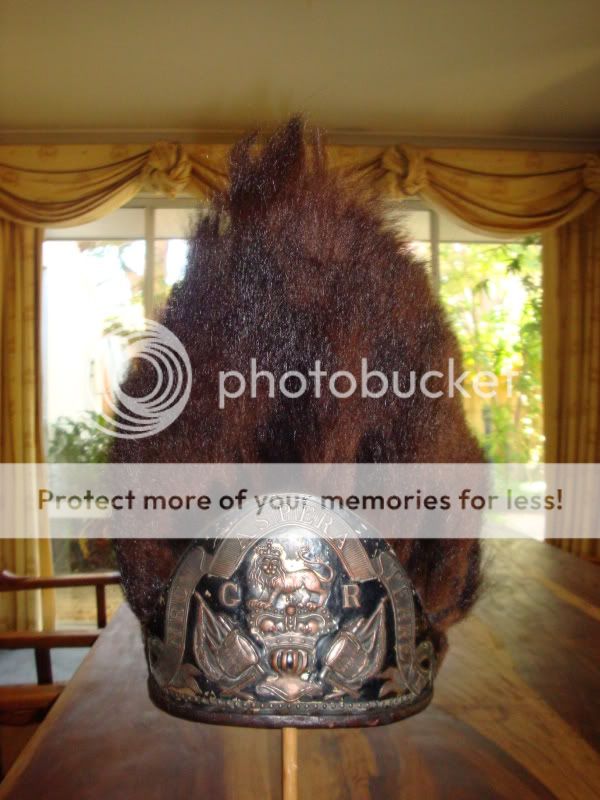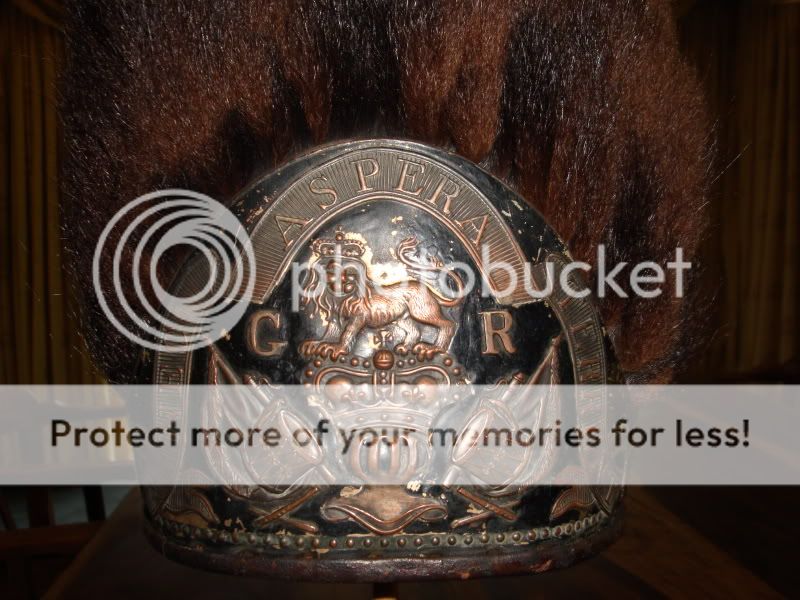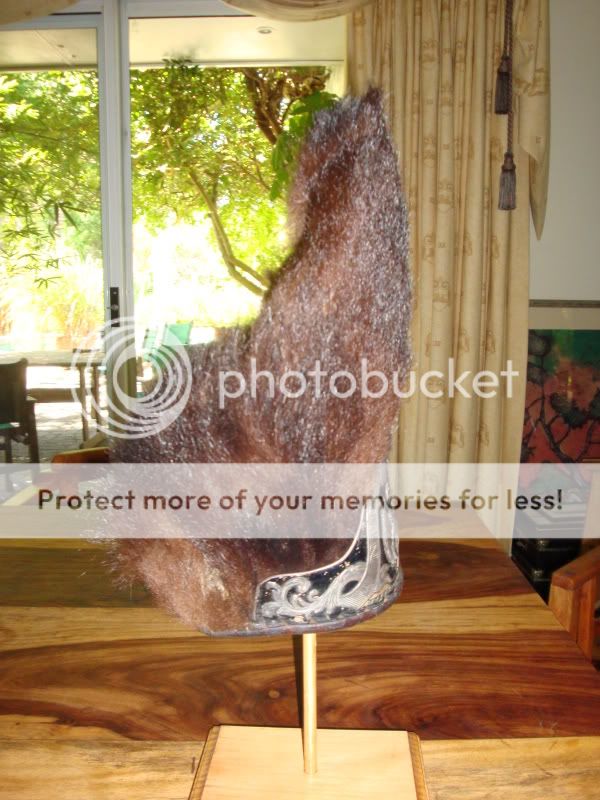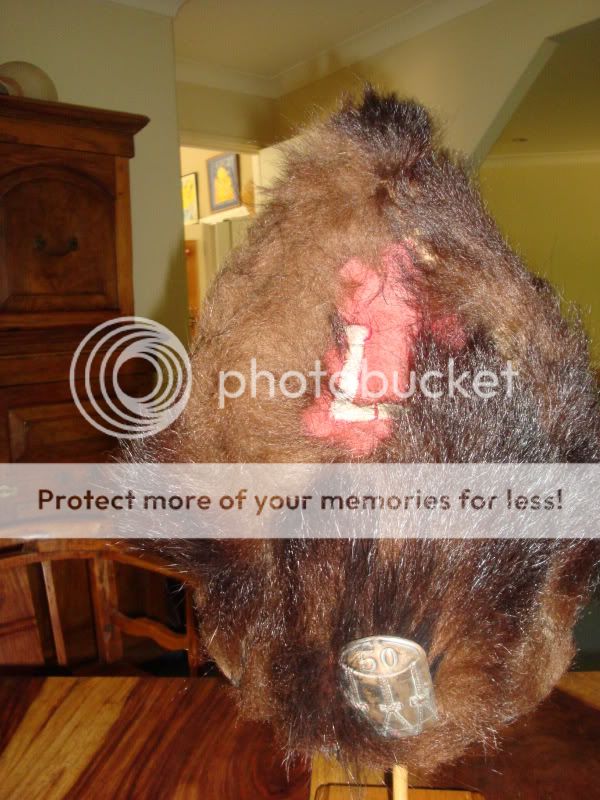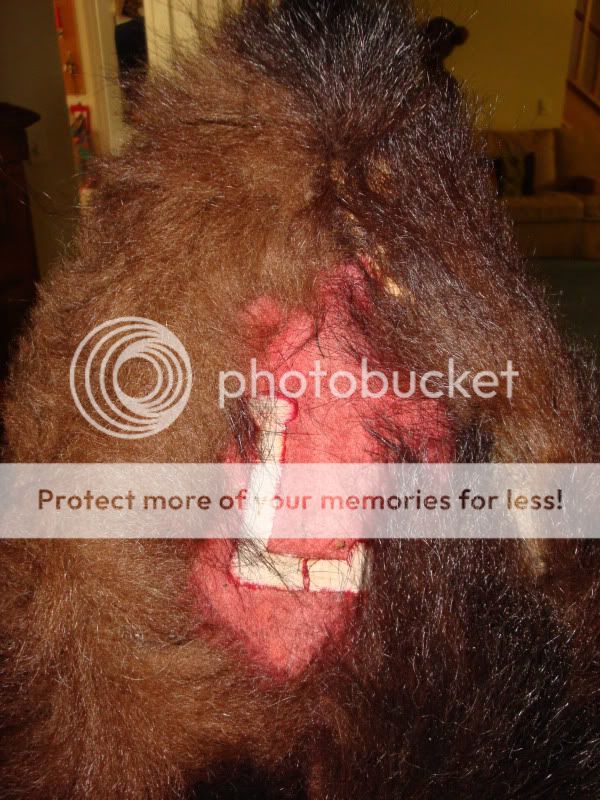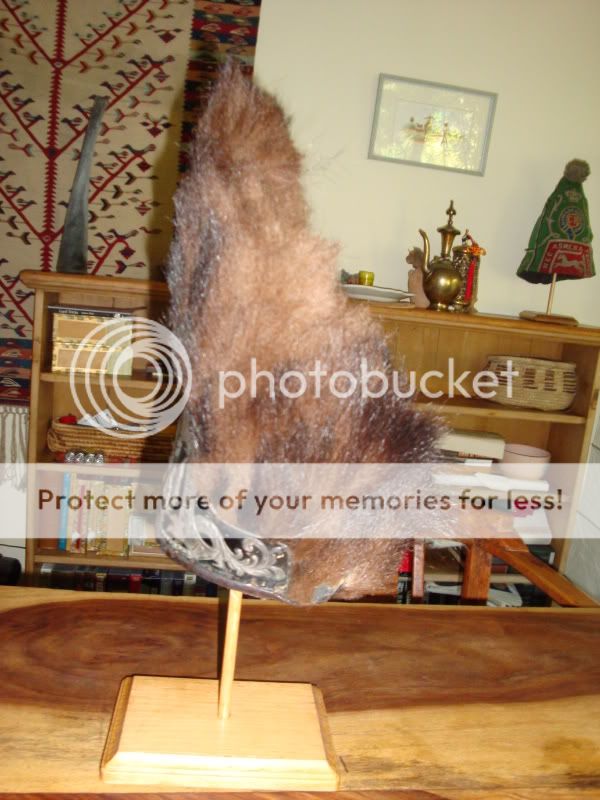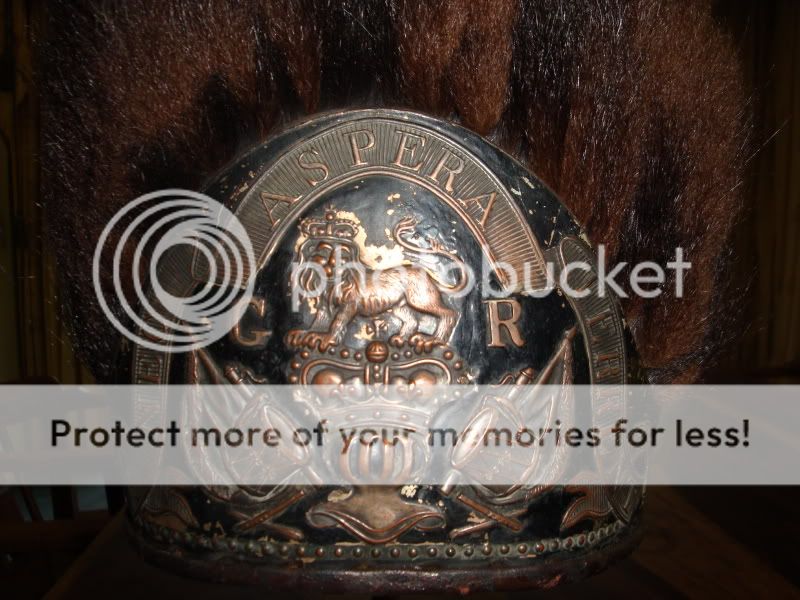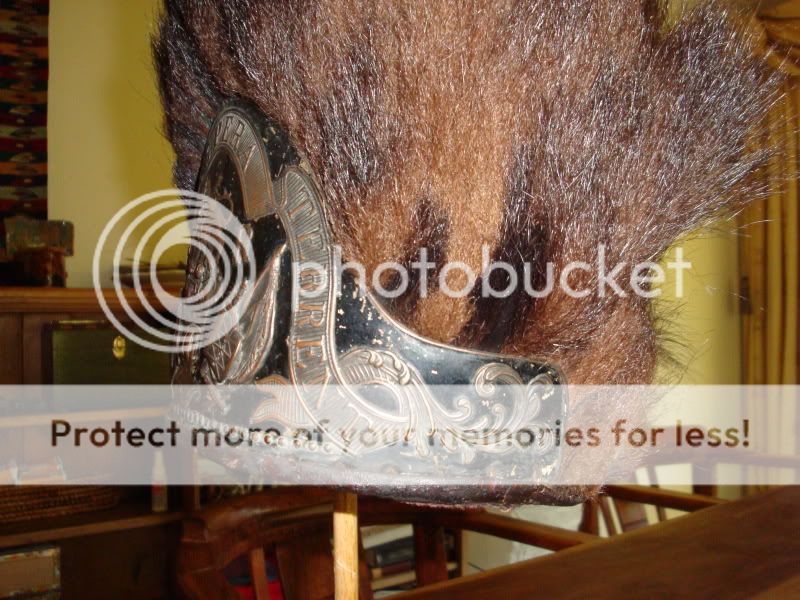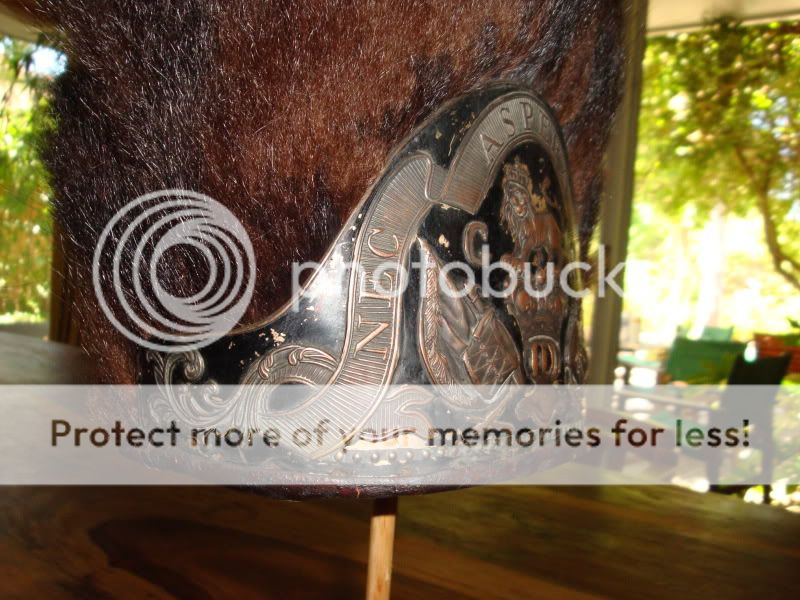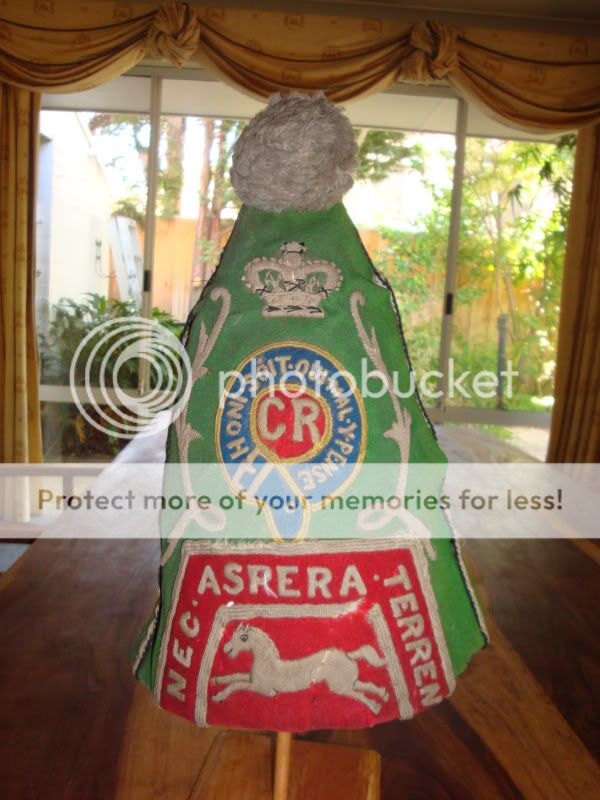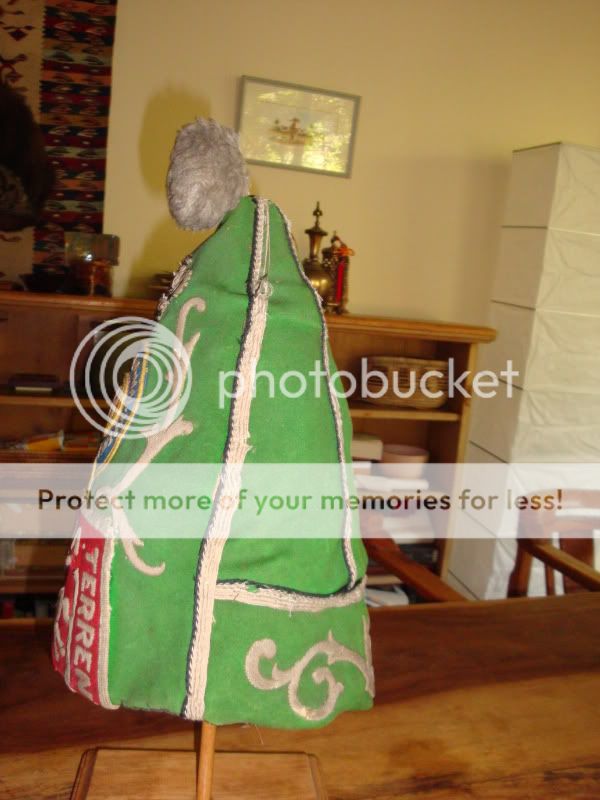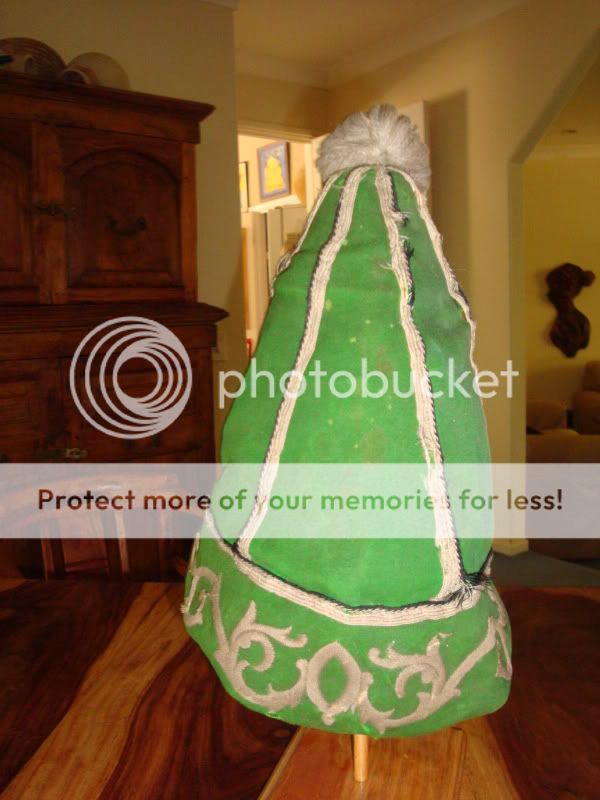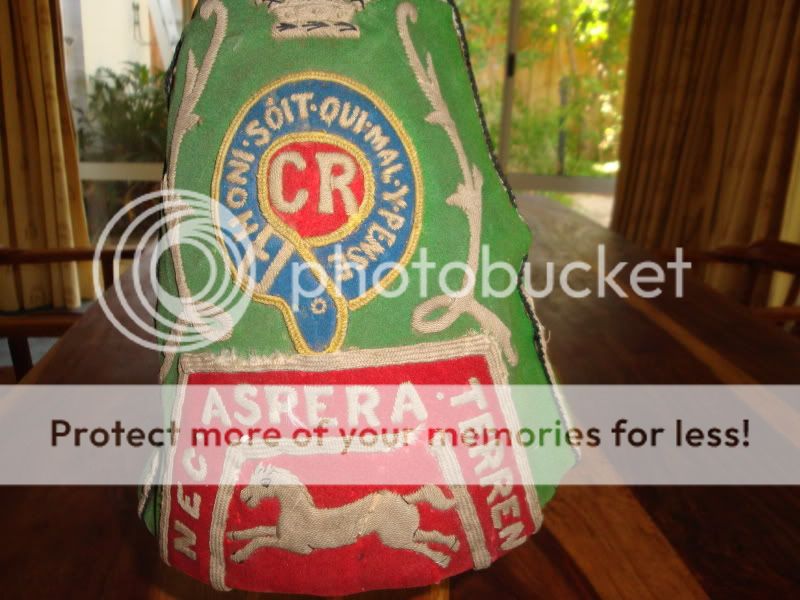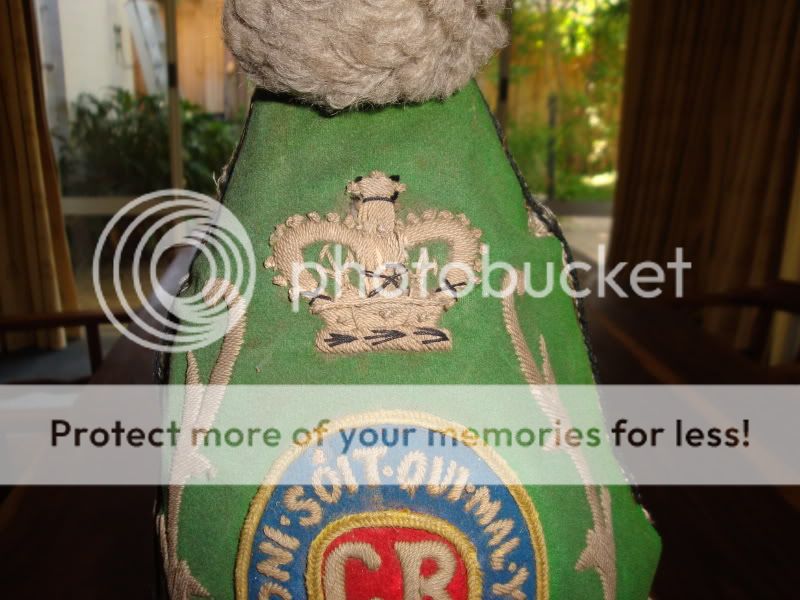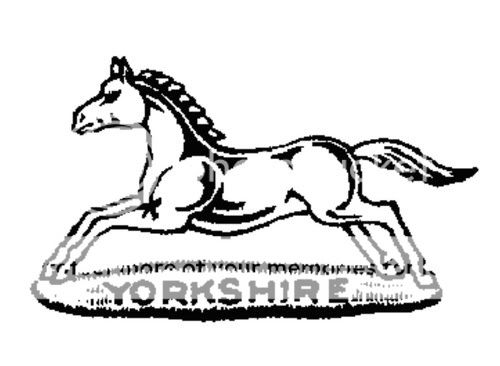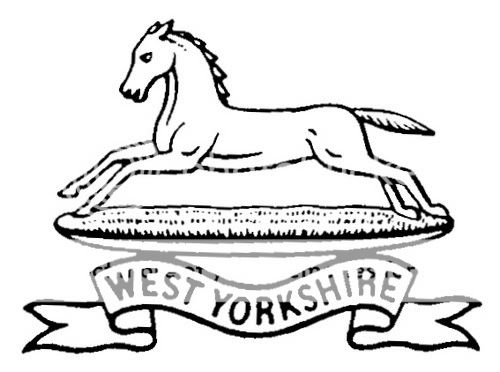You are using an out of date browser. It may not display this or other websites correctly.
You should upgrade or use an alternative browser.
You should upgrade or use an alternative browser.
Not Exactly Pickelhaubes. British Grenadier Mitre Caps ?
- Thread starter newbe
- Start date
Hi Newbe
Now those are two interesting looking fellows. Any history or provenence of how you came by them? Any photos of the interiors? Have you ever used a UV light on the white embroidery? Any evidence of machine stitching in the lining or body seams? Those are very cool looking pieces of headgear my friend. I know zip about them but would roll the dice on American Revolution era for the hairy one, and perhaps Seven Years War or earlier for the green guy, both British of course, although with the running horse on Mr Greenjeans it might have a Hanover connection, yet Brit too in a way, now where's Joe gone to? :dontknow:
Larmo
Now those are two interesting looking fellows. Any history or provenence of how you came by them? Any photos of the interiors? Have you ever used a UV light on the white embroidery? Any evidence of machine stitching in the lining or body seams? Those are very cool looking pieces of headgear my friend. I know zip about them but would roll the dice on American Revolution era for the hairy one, and perhaps Seven Years War or earlier for the green guy, both British of course, although with the running horse on Mr Greenjeans it might have a Hanover connection, yet Brit too in a way, now where's Joe gone to? :dontknow:
Larmo
joerookery
Well-known member
Mr. Greenjeans
I don't know but this should be pretty easy to find out from the British guys. I am not even sure this is a military hat. It might be some sort of an Association or veterans thing. there is a British regimental symbol on the top that maybe Peter can reference and the horse does look King's German Legion or Hanover -- however, there is a little known trick to these horses in that the horse is displayed jumping over a piece of ground during the kingdom of Hanover. Look at my old Shako and you can see the ground. After Prussia annexed Hanover the horse was displayed without the ground. Not sure what this is.
zipperheads9
New member
The fur Cap i have seen as late as 1812 and the other is !760's . I would like to see which units the came from ,and where they were worn .The Fur cap has a Latin Motto and anumber on it ,but the unit may have been twined or dibanded at some point.
Mark
Mark
stuart_bates
New member
The bearskin mitre cap was officially authorised for Grenadier and Fusilier companies by the Warrant of 1768. On the front was to be the King's crest, of silver plated metal, on a black background and with the motto "Nec Aspera Terrent."
The bearskin cap shown is to the Grenadier company of the 50th Regiment of Foot and is a drummer/fifer's cap as shown by the drums etc. on the front plate and the drum on the rear.
The other (cloth) cap I cannot comment upon.
"Nec Aspera Terrent" was used by Grenadier and Light companies in the 18th Century and is the motto of several British Regiments e.g. The King's Liverpool as well as the Yorkshire regiments previously mentioned.
Stuart
The bearskin cap shown is to the Grenadier company of the 50th Regiment of Foot and is a drummer/fifer's cap as shown by the drums etc. on the front plate and the drum on the rear.
The other (cloth) cap I cannot comment upon.
"Nec Aspera Terrent" was used by Grenadier and Light companies in the 18th Century and is the motto of several British Regiments e.g. The King's Liverpool as well as the Yorkshire regiments previously mentioned.
Stuart
Morning Gents
Thought I'd dive into the library a bit this morning in an attempt to find some reference to our green mitre cap. Something was digging away in the old cobweb bedecked memory vault about it. So off to the library I went, coffee in hand.
First book I pulled out was Military Fashion by Mollo 1972. On page 46 two very similar examples belonging to the National Army Museum are shown. The example on the left being very similar to Newbe's green one down to the running horse emblem (Nec Aspera Terrent motto) but without the crown above. It is identified as a Grenadier Officers Mitre Cap of the 3rd Foot, ca 1750, the other being an officers cap from the Honorable Artillery Company Ca.1710. Both caps, or hats lay flat and are heavily decorated with silver bullion embroidery. Since Newbe's hat is embroidered in what appears to be cotton we may presume it to be an enlisted example. The color photo used in the book to illustrate the two caps is rather poor. The Honorable Artillery Company cap appears to be of red velvet but the other could be green or yellow and perhaps of velvet as well. The text which accompanies this page of photos is rather brief in detail as the book deals with military fashion of many countries in general. It simply states "The more common type of grenadier cap was the stiffened conical cloth cap with a tassel at the top, and small turnbacks, front and rear, embroidered with various devices. The English pattern had a tall mitre-shaped cloth front".
The second book I opened, and the first book I ever puchased regarding the collecting of Militaria was Battle Dress by Wilkinson 1970. In the chapter entitled British Uniform:The Early Years he states, "With the advent of the Hanoverian succession a number of minor changes took place (with the grenadier cap), such as the introduction of the arms of Hanover including the white horse-the grenadier or "mitre" cap with its embroidered badges was now firmly established, albeit with regimented differences. Most were fairly tall, with a little tuft at the crown and a peak which was folded up, and bore on the front flap the white horse of Hanover". In the same chapter he quotes the 1768 clothing warrant for the fur trimmed grenadier cap as Stuart pointed out.
I hope this helps a little in our quest but it doesn't answer Newbe's most important question, are they original? Man they sure look good, and rare, wow! It would be great to see some photos of the interiors.
Larmo
Thought I'd dive into the library a bit this morning in an attempt to find some reference to our green mitre cap. Something was digging away in the old cobweb bedecked memory vault about it. So off to the library I went, coffee in hand.
First book I pulled out was Military Fashion by Mollo 1972. On page 46 two very similar examples belonging to the National Army Museum are shown. The example on the left being very similar to Newbe's green one down to the running horse emblem (Nec Aspera Terrent motto) but without the crown above. It is identified as a Grenadier Officers Mitre Cap of the 3rd Foot, ca 1750, the other being an officers cap from the Honorable Artillery Company Ca.1710. Both caps, or hats lay flat and are heavily decorated with silver bullion embroidery. Since Newbe's hat is embroidered in what appears to be cotton we may presume it to be an enlisted example. The color photo used in the book to illustrate the two caps is rather poor. The Honorable Artillery Company cap appears to be of red velvet but the other could be green or yellow and perhaps of velvet as well. The text which accompanies this page of photos is rather brief in detail as the book deals with military fashion of many countries in general. It simply states "The more common type of grenadier cap was the stiffened conical cloth cap with a tassel at the top, and small turnbacks, front and rear, embroidered with various devices. The English pattern had a tall mitre-shaped cloth front".
The second book I opened, and the first book I ever puchased regarding the collecting of Militaria was Battle Dress by Wilkinson 1970. In the chapter entitled British Uniform:The Early Years he states, "With the advent of the Hanoverian succession a number of minor changes took place (with the grenadier cap), such as the introduction of the arms of Hanover including the white horse-the grenadier or "mitre" cap with its embroidered badges was now firmly established, albeit with regimented differences. Most were fairly tall, with a little tuft at the crown and a peak which was folded up, and bore on the front flap the white horse of Hanover". In the same chapter he quotes the 1768 clothing warrant for the fur trimmed grenadier cap as Stuart pointed out.
I hope this helps a little in our quest but it doesn't answer Newbe's most important question, are they original? Man they sure look good, and rare, wow! It would be great to see some photos of the interiors.
Larmo
stuart_bates
New member
Having looked at the cloth cap again I have the following observations to make, although information is somewhat sketchy and sometimes contradictory, but this latter may be due to different periods in which the cap was used.
1. The garter containing the Royal Cipher is wrong. The portion of the garter after the buckle typically had 2 or three holes. The portion containing the cipher is not a circle and the garter itself varies in width. I doubt that the end of the garter should be overlaid by the piping of the flap containing the White horse. And I think the garter motto background should also be green as for the front of the cap. I have never seen “dots” between the words of the garter motto
2. The cipher itself looks more like “CR” than “GR” and was ordered to be worn, unless a special device was authorised, in 1742
3. There is no regimental number on the rear
4. The base of the rear does not have on it the flaming grenade
5. The base of the cap is unfinished as can be seen from the “absence” of the terminating “T” of “TERRENT”. It should have a binding, usually of twisted material in the colours of green and yellow
6. The White Horse of Hanover should be running on “ground” of some sort
7. The rear of the cap should be red
The front part of the cap was usually made of buckram, a stiff cloth made of cotton, over which woolen cloth in the colour of the regiment was fixed. Is the front of the cap rigid? Where the front and back parts met were two round pieces of cane which were intended to keep the rear smooth. Stitches which showed on the exterior were covered by white woolen tape.
I would love to see an interior shot of the cap.
Stuart
1. The garter containing the Royal Cipher is wrong. The portion of the garter after the buckle typically had 2 or three holes. The portion containing the cipher is not a circle and the garter itself varies in width. I doubt that the end of the garter should be overlaid by the piping of the flap containing the White horse. And I think the garter motto background should also be green as for the front of the cap. I have never seen “dots” between the words of the garter motto
2. The cipher itself looks more like “CR” than “GR” and was ordered to be worn, unless a special device was authorised, in 1742
3. There is no regimental number on the rear
4. The base of the rear does not have on it the flaming grenade
5. The base of the cap is unfinished as can be seen from the “absence” of the terminating “T” of “TERRENT”. It should have a binding, usually of twisted material in the colours of green and yellow
6. The White Horse of Hanover should be running on “ground” of some sort
7. The rear of the cap should be red
The front part of the cap was usually made of buckram, a stiff cloth made of cotton, over which woolen cloth in the colour of the regiment was fixed. Is the front of the cap rigid? Where the front and back parts met were two round pieces of cane which were intended to keep the rear smooth. Stitches which showed on the exterior were covered by white woolen tape.
I would love to see an interior shot of the cap.
Stuart
Many thanks everyone for the comments. They are very highly appreciated. I should buy you all a case of beer.
Mr hairy is looking like passing muster?
The jury is out on Mr Green.
Concerning Mr Green. Stuart I looked underneath and the T in TERRENT is there. It's just tucked away. You can just about make it out. I will add some photographs this weekend to show you. I thought we may have a dyslexic seamstress for a moment.
That brings me on to my next observation.
There is indeed a liner but it is hidden. Sometime someone has sewn a liner inside the cap, for obvious reasons. Underneath the cloth is a thin ?leatherish? liner which is crumbling away like saw dust. So at some time this extra cloth liner has been attached to stop saw dust dropping all over the place, like it is doing now. This addition is now dragging a significant portion of the original into the underside of the cap. I will remove the liner this weekend a see what is really there.
The stitching is very fine quality and is almost certainly hand sewn, but is disintegrating fast.
Will post some zoomed images.
It may be the base has been trimmed off sometime but we will find out shortly.
The cypher looks like it never had a G.
No flaming grenades.
The horse looks a bit drunk as well.
More on Mr Green shortly.
Mr hairy is looking like passing muster?
The jury is out on Mr Green.
Concerning Mr Green. Stuart I looked underneath and the T in TERRENT is there. It's just tucked away. You can just about make it out. I will add some photographs this weekend to show you. I thought we may have a dyslexic seamstress for a moment.
That brings me on to my next observation.
There is indeed a liner but it is hidden. Sometime someone has sewn a liner inside the cap, for obvious reasons. Underneath the cloth is a thin ?leatherish? liner which is crumbling away like saw dust. So at some time this extra cloth liner has been attached to stop saw dust dropping all over the place, like it is doing now. This addition is now dragging a significant portion of the original into the underside of the cap. I will remove the liner this weekend a see what is really there.
The stitching is very fine quality and is almost certainly hand sewn, but is disintegrating fast.
Will post some zoomed images.
It may be the base has been trimmed off sometime but we will find out shortly.
The cypher looks like it never had a G.
No flaming grenades.
The horse looks a bit drunk as well.
More on Mr Green shortly.
joerookery
Well-known member
The horse looks a bit drunk as well.
Well at least it is a happy drunk! This has been a great exchange I am learning all the time! And you can buy us all a case of beer -- come to SOS next year and we will give you the opportunity.
Hi Newbe
Glad you're back. The hairy guy has passed muster pattern-wise but the originality factor is still up in the air.
Did a look on the net on sewing machines and it appears that the first practical working model didn't appear until the 1830's, although, attempts were made by others as early as 1790. Since your two hats both date prior to 1790 there shouldn't be machine stitching present in either of them. All hand stitching and emboidery only with the exception of post manufacture repairs. Hollywod did some wonderful creations tailoring-wise in the 1930's and went to great expense and effort for authenticity.
Your two Mitre hats are wonderful looking things and I really hope they are of the period they represent, that would be terrific. Looking forward to the interior photos.
I prefer Sam Adams if you're buying, Cheers ccasion5: ,
ccasion5: , 
Larmo
Glad you're back. The hairy guy has passed muster pattern-wise but the originality factor is still up in the air.
Did a look on the net on sewing machines and it appears that the first practical working model didn't appear until the 1830's, although, attempts were made by others as early as 1790. Since your two hats both date prior to 1790 there shouldn't be machine stitching present in either of them. All hand stitching and emboidery only with the exception of post manufacture repairs. Hollywod did some wonderful creations tailoring-wise in the 1930's and went to great expense and effort for authenticity.
Your two Mitre hats are wonderful looking things and I really hope they are of the period they represent, that would be terrific. Looking forward to the interior photos.
I prefer Sam Adams if you're buying, Cheers
Larmo
Sam Adams brewed a world class Weiß beer, but unfortunatly, they contaminated it with a terrible lemon flavoring.Larmo said:I prefer Sam Adams if you're buying, Cheersccasion5: ,

Larmo
gus
stuart_bates
New member
I figured that the "T"would be wrapped inside the cap. What you seem to have is leather rot to the edge binding which someone has tried to remedy by covering it up and in the process ruining the cap.
However, as it stands, I don't think it is authentic and whilst I don't know about re-enactments I do think they attempt to achieve a closer approximation to authenticity than this cap exhibits.
However, I am no expert.
What do you mean by "The cypher looks like it never had a G?" Are you saying that the letter is indeed a "C" and not a "G" from which the tail has come adrift?
Cheers,
Stuart
PS. Fuller's London Pride for me ccasion
ccasion  ccasion5:
ccasion5:
However, as it stands, I don't think it is authentic and whilst I don't know about re-enactments I do think they attempt to achieve a closer approximation to authenticity than this cap exhibits.
However, I am no expert.
What do you mean by "The cypher looks like it never had a G?" Are you saying that the letter is indeed a "C" and not a "G" from which the tail has come adrift?
Cheers,
Stuart
PS. Fuller's London Pride for me
minihelmets
New member
it's a shame this thread stopped this was becoming very intersting.,. Where did you come accross them??
I know values must not be discussed , But that is regarding pickelhauben and related headdress presumably... but what would the value of these be if they went into say a specialist military auction? maybe in this case ., i should ask what the reserve would be..
anyway more of this topic!
I know values must not be discussed , But that is regarding pickelhauben and related headdress presumably... but what would the value of these be if they went into say a specialist military auction? maybe in this case ., i should ask what the reserve would be..
anyway more of this topic!
stuart_bates
New member
I would say that the Bearskin mitre cap would fetch GBP6,000+ as they are very rare indeed and a bandsman's more so.
Stuart
Stuart
not to pull a shang tsung, almost a year after the thread was opened, but I figured I had to comment here, with what I know about the British army from the period 1740-1764:
the mitre cap, and I'm not certain of this, is likely from the 2nd regiment of foot. the CR makes sense only in this case, since George II's wife was Queen Caroline. the royal warrant of 1751 makes it very clear that the mitre ought to have the queen's monogram, with a garter round it, and a sea green facing (the shade of green in the photo is pretty close-if faded). the queen's cyper and garter motif was also on the flag of the regiment. here is a quote from the warrant:
"On the Grenadier Caps, the Queen's Cypher and Crown, as in the Colours; White Horse and motto "Nec asperra terrent" on the Flap.
The Drums and Bells of Arms to have the Queen's Cypher painted on them in the same manner, and the Rank of the Regiment underneath."
mind you, this particular feature was confirmed as being official-so it was already there prior to 1751.
because of the lack of a number on the band, I'm inclined to say it's pre-1751, when numbers were ordered placed on the back of the band-which was to be sea green in color of course.
but as mentioned at the beginning, this isn't certain: the CR and the color are what I'm going on.
the bearskin is easy: it's from the 50th regiment of foot. the warrant from 1768 makes it clear that the number of the regiment was on the back side of the bearskin. 50 in Latin numerology is L of course. the size makes it likely from the revolutionary period, though as mentioned here, similar patterns were present as late as 1812. the presence of the trophies motif (drums and flags) points to it being a drummer's cap-something a couple of users have already alluded to.
again, I'm going by what I know.
discuss.
the mitre cap, and I'm not certain of this, is likely from the 2nd regiment of foot. the CR makes sense only in this case, since George II's wife was Queen Caroline. the royal warrant of 1751 makes it very clear that the mitre ought to have the queen's monogram, with a garter round it, and a sea green facing (the shade of green in the photo is pretty close-if faded). the queen's cyper and garter motif was also on the flag of the regiment. here is a quote from the warrant:
"On the Grenadier Caps, the Queen's Cypher and Crown, as in the Colours; White Horse and motto "Nec asperra terrent" on the Flap.
The Drums and Bells of Arms to have the Queen's Cypher painted on them in the same manner, and the Rank of the Regiment underneath."
mind you, this particular feature was confirmed as being official-so it was already there prior to 1751.
because of the lack of a number on the band, I'm inclined to say it's pre-1751, when numbers were ordered placed on the back of the band-which was to be sea green in color of course.
but as mentioned at the beginning, this isn't certain: the CR and the color are what I'm going on.
the bearskin is easy: it's from the 50th regiment of foot. the warrant from 1768 makes it clear that the number of the regiment was on the back side of the bearskin. 50 in Latin numerology is L of course. the size makes it likely from the revolutionary period, though as mentioned here, similar patterns were present as late as 1812. the presence of the trophies motif (drums and flags) points to it being a drummer's cap-something a couple of users have already alluded to.
again, I'm going by what I know.
discuss.
Ibrahim and fellow collectors.
Thanks very much for the information.
Very useful and very informative.
You have helped enormously. Amazing to believe these are of any great value?
The history behind them is amazing though. A local museum here has mentioned the 50 th was stationed in New York at the time of the "rebellion".
Mr Green in crumbling away fast. There is a leather liner inside which is raining down fine fragments of leather and dust. I fear his days are numbered.
All the best
Thanks very much for the information.
Very useful and very informative.
You have helped enormously. Amazing to believe these are of any great value?
The history behind them is amazing though. A local museum here has mentioned the 50 th was stationed in New York at the time of the "rebellion".
Mr Green in crumbling away fast. There is a leather liner inside which is raining down fine fragments of leather and dust. I fear his days are numbered.
All the best

